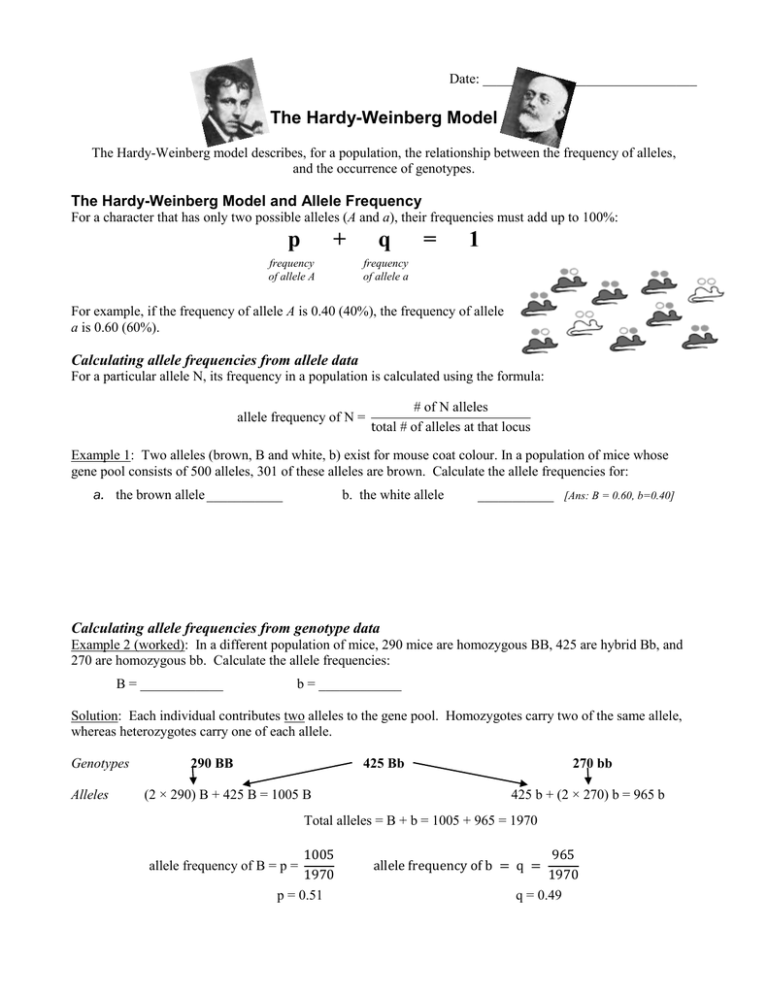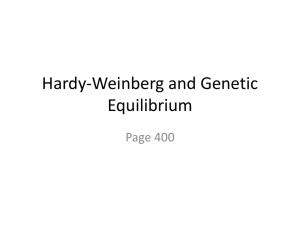The Hardy-Weinberg Model
advertisement

Date: _______________________________ The Hardy-Weinberg Model The Hardy-Weinberg model describes, for a population, the relationship between the frequency of alleles, and the occurrence of genotypes. The Hardy-Weinberg Model and Allele Frequency For a character that has only two possible alleles (A and a), their frequencies must add up to 100%: p + frequency of allele A q = 1 frequency of allele a For example, if the frequency of allele A is 0.40 (40%), the frequency of allele a is 0.60 (60%). Calculating allele frequencies from allele data For a particular allele N, its frequency in a population is calculated using the formula: allele frequency of N = # of N alleles total # of alleles at that locus Example 1: Two alleles (brown, B and white, b) exist for mouse coat colour. In a population of mice whose gene pool consists of 500 alleles, 301 of these alleles are brown. Calculate the allele frequencies for: a. the brown allele ___________ b. the white allele ___________ [Ans: B = 0.60, b=0.40] Calculating allele frequencies from genotype data Example 2 (worked): In a different population of mice, 290 mice are homozygous BB, 425 are hybrid Bb, and 270 are homozygous bb. Calculate the allele frequencies: B = ____________ b = ____________ Solution: Each individual contributes two alleles to the gene pool. Homozygotes carry two of the same allele, whereas heterozygotes carry one of each allele. Genotypes Alleles 290 BB 425 Bb (2 × 290) B + 425 B = 1005 B 270 bb 425 b + (2 × 270) b = 965 b Total alleles = B + b = 1005 + 965 = 1970 1005 1970 p = 0.51 allele frequency of B = p = 965 1970 q = 0.49 allele frequency of b = q = Example 3: In centaurs, the allele for curly tails (T) is incompletely dominant to the allele for straight tails (t). The hybrid genotype results in wavy tails. In a population of 1500 centaurs, 315 have curly tails, 820 have wavy tails, and the remainder has straight tails. a. How many total alleles are in this gene pool? ____________________________ b. Determine the allele frequencies of: T = ____________ t = ____________ [Ans: T = 0.48, t=0.52] The Hardy-Weinberg model describes a state of equilibrium. If a population is in equilibrium, the alleles in the gene pool get shuffled around into new combinations, but the overall composition of the gene pool remains constant from generation to generation. Hardy and Weinberg independently arrived at the conclusion that in order to maintain this equilibrium, a set of conditions must exist. In order for populations to maintain equilibrium, five conditions must be met: 1. The population size is infinitely large. 2. All members of the population breed, and mating is random. 3. No mutation occurs. This prevents new alleles from appearing. 4. No migration occurs. This prevents alleles entering or leaving the population. 5. No natural selection occurs. A population for which these conditions are met is set to be in a state of Hardy-Weinberg equilibrium. The allele frequencies will not change from generation to generation. What a second... do these conditions seem familiar?? The Hardy-Weinberg model sets out conditions under which allele frequencies don’t change. What do we call change in allele frequencies? ___________________________________ If a population’s allele frequencies change, or the observed genotype frequencies do not match the expected frequencies, the population is not in Hardy-Weinberg equilibrium. Such a population is undergoing evolution. Thus, by describing this idealized population in which allele frequencies do not change, Hardy and Weinberg defined the conditions required for evolution. For how many generations was this population in H-W equilibrium? _____ Describe the change that occurred in this population’s gene pool in Generation 5. __________________________________ __________________________________ The Hardy-Weinberg Model and Genotype Frequency The allele frequencies p and q represent the probability of sampling either of these alleles in a population. Using the allele frequencies, the genotype frequencies can be determined: If p = 0.40 and q = 0.60, Formula p × p = p2 q × q = q2 pq + pq = 2pq Frequency of AA genotype Frequency of aa genotype Frequency of Aa genotype p2 2pq + q2 frequency of Aa frequency of aa + frequency of genotype AA Calculation (0.40)2 = 0.16 (0.60)2 = 0.36 2 (0.40) (0.60) = 0.48 = there are two ways of obtaining the Aa genotype 1 Example 4: In the American Caucasian population approximately 70% of people can taste the chemical phenylthiocarbamide (PTC) (the dominant phenotype), while 30% are non-tasters (the recessive phenotype). Determine the expected frequency of: Genotype Frequency _____________ b) the recessive allele ______ ______ c) the dominant allele ______ _____________ d) homozygous tasters ______ _____________ e) heterozygous tasters ______ _____________ a) homozygous recessive phenotype _____________ Answers: a) b) c) The recessive phenotype q2 = 30% or 0.30 Therefore: q = 0.5477 (square root of 0.30) Therefore: p = 0.4522 (1 – q = p so 1- 0.5477 = 0.4523) d) e) f) Then use p and q in the Hardy-Weinberg equation to solve: Homozygous dominant: p2 = 0.2046 (p x p = 0.4523 x 0.4523 ) Heterozygous: 2pq = 0.4953 To solve Hardy-Weinberg Problems follow these steps: 1. Examine the information to determine what piece of information you have been given about the population. 2. Determine the value of p or q. If this is achieved, then every other value in the equation can be determined by simple calculation. 3. Take the square root of q2 to find q. 4. Determine p by subtracting q from 1 (i.e. p= 1-q). 5. Determine p2 by multiplying p by itself (i.e. p2 = p x p) 6. Determine 2 pq by multiplying p times q times 2. 7. Check that your calculations are correct by adding up the values for p2 + q2 + 2pq = 1. Hardy-Weinberg: Practice Problems 1. In humans, attached ear lobes are caused by the inheritance of two recessive alleles. Free ear lobes are the result of inheriting at least one dominant allele for free ear lobes. The frequency of the recessive allele is 70% (0.7). What would the frequencies of the following be, assuming H-W equilibrium? Alleles: R ________ r ___________ Genotypes: RR _______ rr ___________ Rr _________ 2. From question 1, how many people in a population of 7000 would carry the allele for free ear lobes? ______ 3. Suppose the allele frequencies for the autosomal gene for eye colour in females are B = 0.4 and b = 0.6, where B is brown and b is blue. Assuming H-W conditions, what would be the frequencies for: a) the genotypes of the population? BB = _____ Bb = _____ bb = _____ b) the genotypes of the fifth generation? BB = _____ Bb = _____ bb = _____ c) the phenotypes of the population? Brown = _____ Blue = _____ 4. On an isolated Pacific Ocean Island, there exists a recessive allele for psychic ability which enabled the lucky natives to complete witch doctor school. This recessive allele was found in the population of 2000 natives at a frequency of 10%. a. How many witch doctors are there on the island? ___________ b. What proportion of the population would be hybrid? ___________ 5. If 18 out of 50 lizards sampled has the recessive phenotype for short tails (tt), a. What would be the proportion of t alleles in the lizard population? _____________ b. What would be the allele frequency for the dominant allele? _____________ c. What percent of the population would be heterozygous? ______________ 6. Assume that in sheep, white wool colour is dominant to black wool colour. If 25% of the sheep in a large population have black wool, calculate: a. the allele frequencies of the two types of wool colour. __________________________ b. the expected proportion of homozygous white sheep. ____________ c. the expected proportion of hybrid sheep. ____________ d. the expected number of white sheep in a population of 750? ____________ 7. A population of 64 individuals is tested for their genotype at a particular locus, R. The observed frequencies are as follows: RR = 37 Rr = 20 rr = 7 a. Determine the allele frequencies for R and r. R _________ r _________ b. Use the Hardy-Weinberg equation to determine the expected genotypic proportions. RR _________ Rr _________ rr _________ c. Use the proportions above to determine the expected frequencies in the population of 64. RR _________ Rr _________ rr _________ d. Use a chi square test to determine whether the population is in Hardy-Weinberg equilibrium (if the genotypes occur in the expected frequencies). Use a significance level of 0.05. Answers: 1. R = 30%, r = 70% (you are given this), RR = 9%, rr = 49%, Rr = 42%; 2. 3570; 3. (a) BB – 0.16, Bb – 0.48, bb – 0.36; (b) same as (a); (c) brown – 0.64, blue – 0.36; 4. (a)20; (b) 0.18 or 18%; 5. (a)0.6; (b) 0.4; (c) 0.48; 6. (a) p=q=0.5; (b)0.25; (c) 0.5; (d) 562.5; 7. (a ) R =p=0.73, r=q=0.27; (b)RR – 0.533, Rr – 0.394, rr – 0.073; (c) RR – 34.1, Rr – 25.2, rr – 4.7; (d)X2 = 2.443; yes it is








